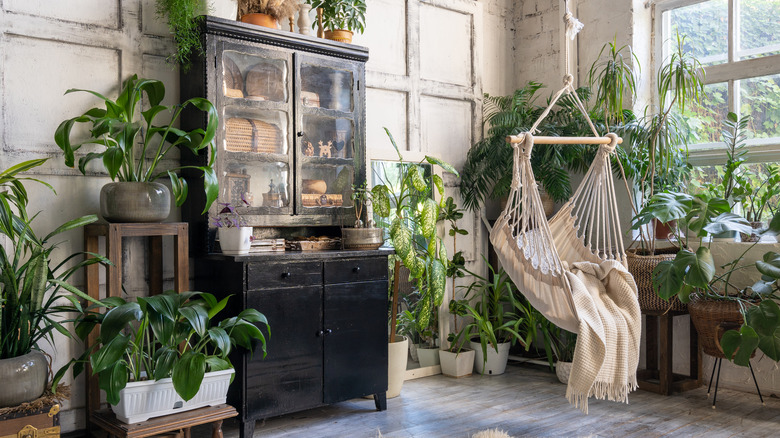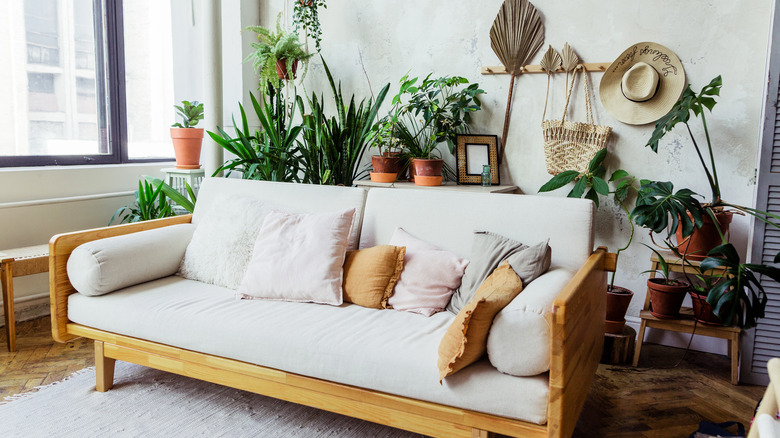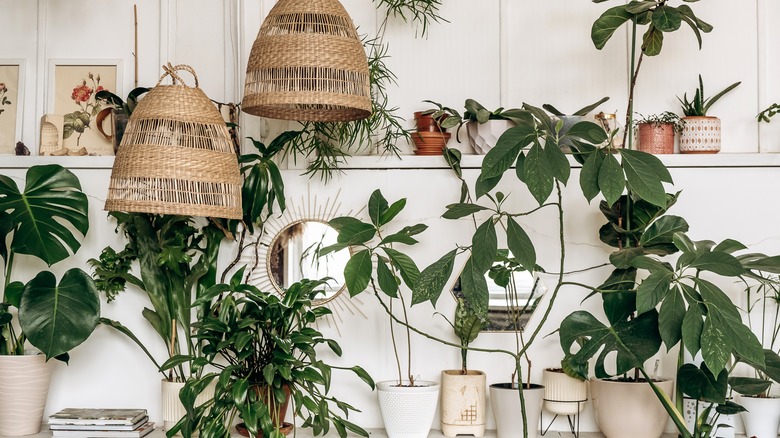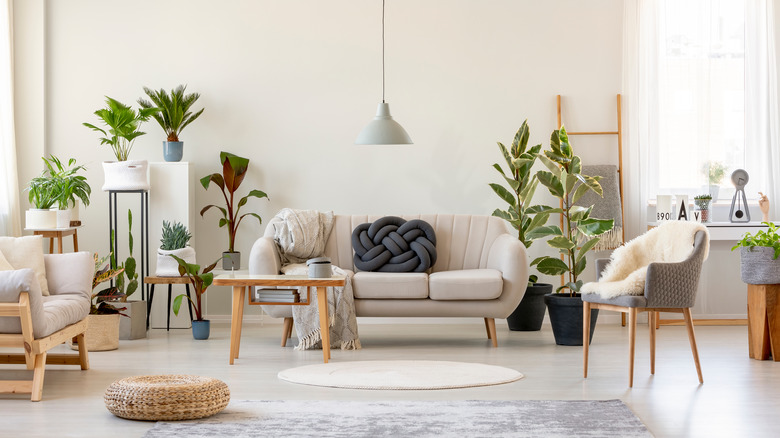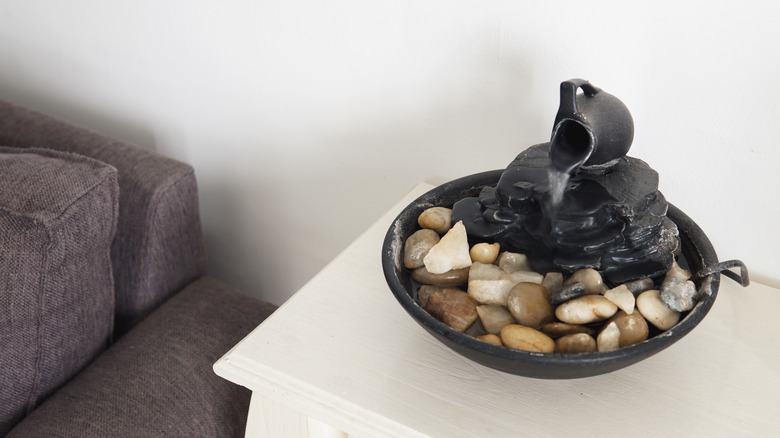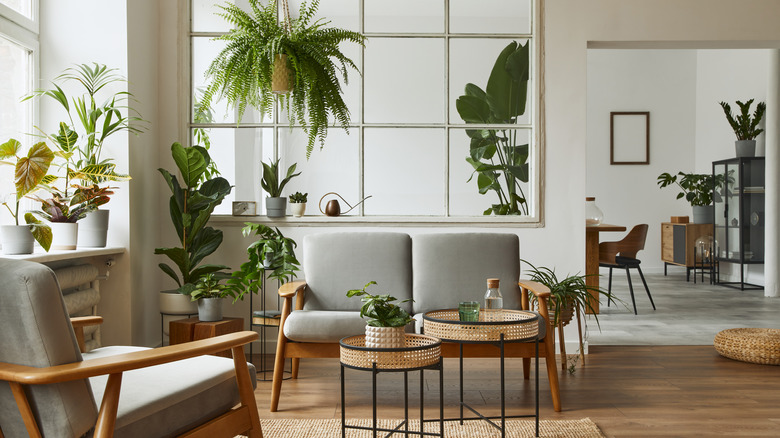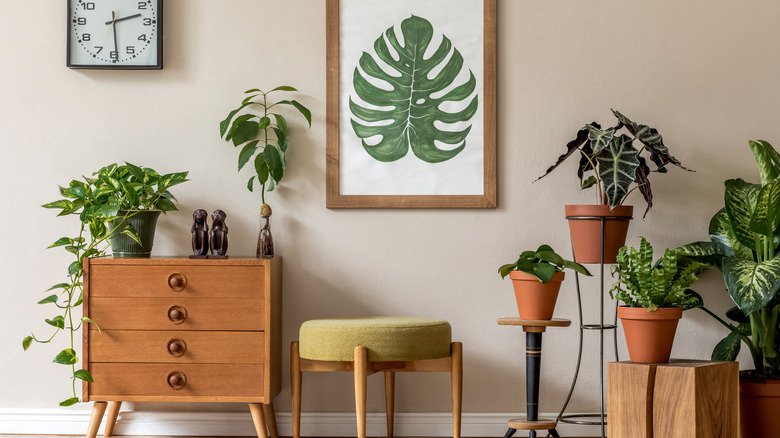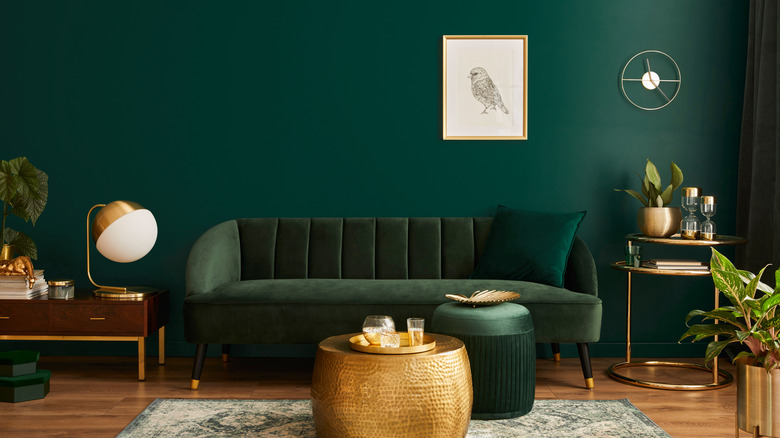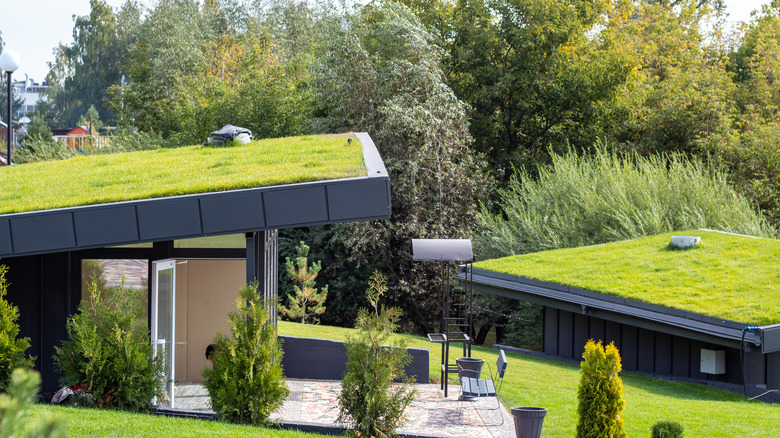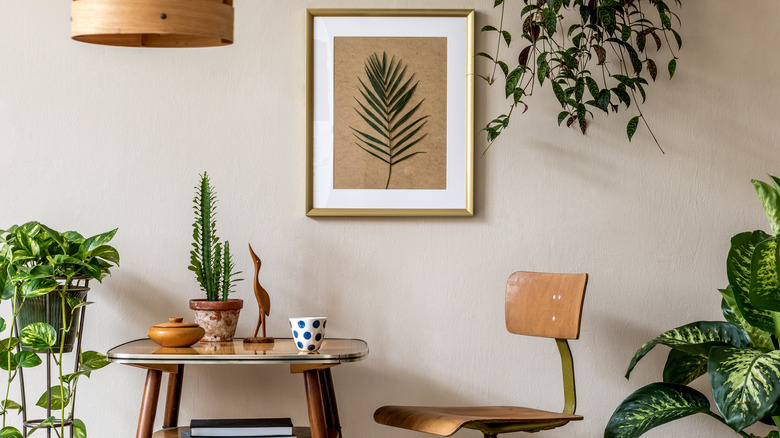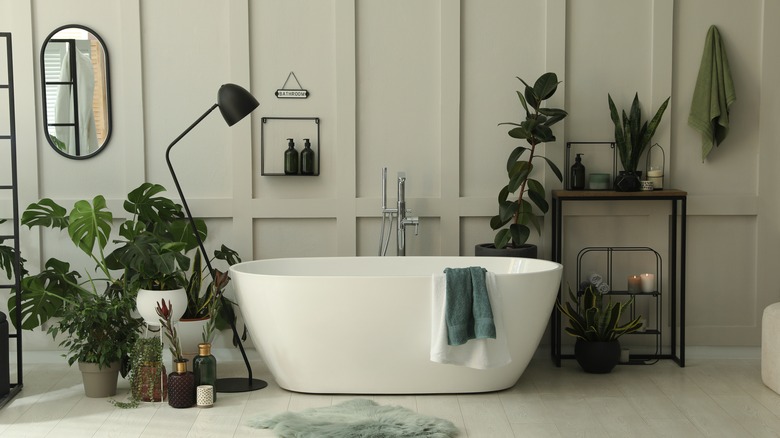The Ultimate Guide To Biophilic Interior Decor
You don't have to be "outdoorsy" in order to enjoy nature and all of its benefits. Create a connection between the outside and the inside by incorporating biophilic design elements into the walls, floors, and furnishings inside your home. Dating back to the 1980s, biophilic decor focuses on including greenery in ways that feel like a conscious part of the home yet connect a space to the great outdoors. The new movement was outlined and spurred by Edward O. Wilson, who openly shared his ideas about humans and nature being interconnected, ultimately having a significant influence on the design trend (via Living Architecture Monitor). A successful biophilia-inspired design will transcend beyond the traditional potted snake plants, succulents, and olive trees you may typically find in people's homes. Ultimately opening new doors for you to experiment with plant-covered walls and the creation of living roofs instead.
This unique style is about more than just adding plants to homes. "Historically, being connected with nature has provided food, clothing, and shelter," interior designer Kristin Bartone told Better Homes and Gardens. "These connections are imprinted in our brains and we are subconsciously comforted by these colors, textures, and patterns." At a time when most people are finding themselves spending their leisure hours indoors, they are seeking opportunities to capture the essence of the environment at home. Through floral patterns, curved furniture, earthy tones, and water elements, find inspiration below for all the ways to decorate a space inspired by biophilic decor for your own home.
Maximize natural lighting indoors
Biophilic decor takes the experience of being outdoors a step further but on the inside. Before we chit-chat about how to make plants the star, you must consider any (and all) natural light sources inside your dwelling. What is more outdoors and necessary for plants (and you), than natural lighting? How much light comes into a space is important to biophilia home decorating. Natural daylight can be one of the best ways to brighten up a biophilic-styled space, instantly bringing the accessories and furniture to life. Check the room for any windows or doors where rays of sunshine can peek through. While plants need the rays of sunshine, so do people. Exposure to sunlight has been linked to positive health benefits like improved mood, weight loss, and increased vitamin D for some people. (via WebMD).
When the room has no natural light, find ways to let it in. It could be through the addition of glass sliding doors, windows, or a ceiling skylight. "It's a way of introducing more natural light into a room, bringing more of the outdoors inside," Shannon Weigand, master designer with Ellis Kitchen and Bath Studio, told HGTV. "Where there's no exterior wall to put a window into, you can create a window in the ceiling. And many skylights can be opened for ventilation in the summer." Consider natural light as vital to biophilic decor as the plants themselves.
Make sure the greenery is overflowing
The most impactful and blatant way for most home decorators to incorporate biophilic decor in their home is through plant life. Biophilic style is all about finding a way to connect to nature. Plants are a great way to do just that. They also make any room they're placed in feel cozier and more alive. The core idea here (at least as far as plants are concerned) is that more is more! Plants should be everywhere in a biophilic home: Sprawling across bookshelves, sitting atop counters, on side tables, cascading a wall, or tucked in corners, plants are the must-have, most recognizable feature to include in a biophilic-inspired place in your home.
In spaces inspired by biophilic decor, plants are often overflowing, taking up any available surface. The surplus of foliage is precisely how to achieve the ultimate biophilic aesthetic. Plants have a natural ability to affect the atmosphere in the room, resulting in a positive impact on whoever enters. "Being in nature drops our cortisol levels, makes us calmer, reduces anxiety, and improves our mood," Bea Pila-Gonzalez, Miami-based interior designer told The New York Times. "It's a physical yearning. We are hungry for the experience of what the outdoors brings to us." So bring it inside! There are plants for places large and small. Pothos, fiddle leaf figs, varied cacti, ferns, spider plants, and peace lilies would be excellent foliage to use that engulfs your space in nature. Include your choice of plant life in any room from the living room, bathroom, entryway, laundry room, and beyond.
Mimic nature by including curved furniture
There is more to biophilic decorating than just putting out potted plants. In fact, there are other accessories and furniture items that are necessary to include in a nature-inspired space. Much like how plants grow in uncontrolled distinct shapes, the furnishings you choose for a room should have varied free-flowing forms as well. In biophilic-inspired decor, it's best to find sofas, loveseats, and accent chairs that mimic the soft edges and subtle curves of the plant life that surrounds it. These pieces should not only fit in the room but should complement the design scheme.
A biophilic space will be void of streamlined designs, sharp angles, and pointy edges. The lack of "perfect lines" allows the organic silhouettes to shine. "Curves in our built environment or furniture evoke a positive human reaction because of the resemblance to the natural shapes found in nature," Zelda Elisco from Abigail-Elise Design Studio told Homes & Gardens. Biophilic design according to Elisco also can "boost the activity of the parasympathetic nervous system, decrease stress levels, and encourage a sense of well-being." Allow the larger furnishings to mimic the existing plant energy in the room. Consider a curved sofa similar to the one available at Crate & Barrel or a wingback chair as possible additions to a living area or den. These soft, curvy profiles will help establish balance and create a cohesive design in any biophilic-inspired room.
Include flowing water elements inside
While plant life and organic forms are central to biophilic design, there are more elements to consider. Water features are also important accents in biophilic interiors. These free-flowing features are incorporated into an interior in ways that complement the design preference and structural attributes of the home. Water elements such as indoor fountains, aquariums, and water walls bring about a sense of depth and reinforce feelings of relaxation in any given space. In order to incorporate water elements in your home, evaluate where you have room for one. Water features vary in size; a tabletop, floor-standing, or wall-mounted fountain are all good options (via Majestic Fountains).
Decorating with water features in a biophilic-inspired home is not only beneficial aesthetically. The combination of plants and other natural features (like water) also has a positive impact on emotional well-being. According to Sunnydaze Decor, water features can help decrease restlessness and stress in a person, ultimately improving one's sleep. The sound of trickling water can create a relaxing ambiance in any room of the house from common areas to personal spaces. Promote peacefulness indoors with water accents that enhance the true nature of biophilic decor. This style is all about bringing more of what you would find outside into your home — even water.
Decorate with other natural elements
Besides water (and plants), biophilic decor is complemented by even more natural materials. Naturally, the style is made up of all things that give it an organic feel. The type of materials you choose to decorate with inside matters to the design. Biophilic style focuses on the inclusion of those items that are environmentally friendly and aesthetically pleasing. All-natural decor is trending in interiors and is easily adaptable for everyday surfaces.
Some elements found outside to include in a home are wood, steel, metal, wicker, stone, organic cotton, or rattan. "Wood, in my opinion, is the best material of them all: it is natural, insulating, and warm. Wood is my life – it is all about wood. I doubt we have done any projects without wood elements," Enrico Cleva, Italian architect and interior designer, told Wood Solutions. Wood of all types is a common accent in biophilic decor as it is as plentiful in nature as the plants themselves. Wood stools, stone accent walls, and woven baskets are often detailed in biophilic-created rooms. Incorporating native materials throughout the house is a nod to the biophilic design scheme that resonates perfectly with the peaceful environment you're creating at home.
Pick out an earthy color palette
A well-chosen color palette can emphasize your biophilic interior. The colors mostly found in this design preference are none other than ones you can find outside. If you are looking for inspiration on what color to paint the walls or furniture, nature is holding all the options. Bring all the warm or cool tones from outside into the space. Opting to improve your place with paint is an inexpensive way to elevate the biophilic profile. Take a moment to imagine how you want the space to feel (amongst the plants of course) or picture a favorite location in nature before choosing. Perhaps it's a lake, beach, or mountainous environment that you would like to escape to. With your inspiration spot in mind and plants in place splash color onto the walls in your home that mimics the landscape.
Pigments for a biophilic-inspired home can be any that appear in nature. These can include the light pinky and yellow shades to the darker blue, green, brown, and other natural hues you may find along the coast or in the hills. "You can't go wrong with creams and terracotta hues," Kirsten Krason told MyDomaine. "A sage green accent pairs well with these colors and is a great nod to the outdoors. Earthy tones are the perfect color palette to complement foliage and other natural furnishings in your space. Some of the best tones to complement a biophilic style preference are only a few steps (out your front door) away.
Plant your feet into a green room color scheme
While earthy-inspired color palettes of browns, tans, and blues are ideal in biophilic decor, they're not the only shades to consider using at home. A single hue is possibly all you need to complete your biophilic oasis. Consider going all out on the green theme as another way to bring nature indoors. Immerse yourself in green — not just in the form of potted plants and cascading wall foliage, but in your color choice, as well. Complement the biophilic-inspired room with varied shades of green on the walls, floor, furniture, and accessories. You can experiment with the tones of green in several areas of the home that correlate with your space. Don't be afraid to mix and match the shades from light to dark to highlight the biophilic influence.
Why all green? The color green is often, "a comforting reminder of the outdoors and our need for a connection with nature," Ginger Curtis at Urbanology Designs told Better Homes and Gardens. One of the main components of biophilic style is to strengthen the link to Mother Nature. The use of one specific color throughout a room elevates the plant life and maximizes the potential impact visually and aesthetically in the environment. Color the room all green from the ceiling to the floor so you can reconnect the interior environment to the one outside for the ultimate biophilic-inspired home.
Create a living roof outdoors
Decorating with vast amounts of small and large plants in all species types is what defines biophilic decor. The concept is to decorate a space with a variety of plant life everywhere you can. The very idea of reconnecting to nature happens through incorporating plants into your interior that benefit your lifestyle. Biophilia is incorporated into interiors in creative ways that are functional just as much as they are beautiful.
One way to incorporate biophilic style in a unique way that is purposeful and pretty is by creating a living roof. A structure that is living outdoors but provides shelter, reduces noise, and acts as an insulator and a habitat. Creating a living roof for your home is easier with the right preparation and materials. Select plants, grasses, and vines of all sorts as foliage that can be combined to create a canopy of plants above your head. Consider the soil depth, insulation preference, and proper drainage, in conjunction with other landscaping tools and materials you'll need to create a green roof (via Treehugger). Capture the very essence of biophilic decor by building an all-natural roof on a wood frame in your outdoor space. The living structure is a completely natural feature paired with environmental elements that are representative of biophilic decor.
Dress the walls with botanical prints
Biophilic decor is all about the plants. This feature alone is what sets the interior style apart from all the rest. However, there are more creative ways to add foliage to the home without the need for soil, water, or sunlight. You still have the opportunity to decorate your home with plants, just not real ones. Consider creating a feature wall in any room of the house from the bedroom to the bathroom with art or wallpaper that is biophilic inspired. The plant-based decor style intertwines plants (real or faux) in all aspects.
Decorators can successfully design a room around herbage by staging picture frames containing botanical still art like the framed piece available at McGee & Co. on the walls in their home. Framed pictures of plants can be the decorative item that's necessary for creating a calm, peaceful atmosphere. Choose to hang a solo portrait above the bed, group several together down a hallway, or arrange an odd number as a feature gallery wall in the living area. Photos, drawings, sketches, prints, and wallpaper patterns of plants, flowers, or landscapes are all encouraged in a biophilic interior. Although artificial, the portrayal of nature will depict a sense of natural beauty indoors without the maintenance. Drench your space in horticultural-inspired prints as these are excellent additions to your contemporary interior that brighten the biophilic style.
Mimic the outdoor scents
Designers add aromas to interiors that heighten the senses and create a more enjoyable experience on another level. Adopt a similar approach when decorating in a style inspired by nature. You can add candles to the biophilic landscape for the ultimate oasis. "Layering votives among flowers and greenery is a fantastic look," interior designer Sara Story told Curbed. "It sets such a good mood, you almost don't even notice the individual pieces, just that it looks beautiful." Find your favorite forest, beach, or rainforest scents that enhance the organic theme and fill the air in your home with natural fragrance. Wick-burning or artificial pillar, tapered, or tea light candles will help illuminate the greenery and make the house smell good.
Whether they are inside or outside, plants give a distinct feeling of tranquility. Biophilic interior decor aims to recreate a similar sensation indoors. Biophilic style is centered around the experience of the outdoors from the comfort of your couch. Through greenery large and small, organic materials, water features, pictures of plant life, curvy furniture, and natural color schemes, you can implement biophilic principles into all aspects of everyday life at home. For the ultimate biophilic-inspired home, consider adapting some or all of these ideas to create an organic, timeless interior filled with natural decor.
